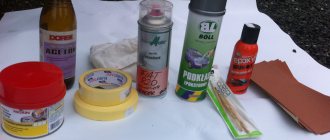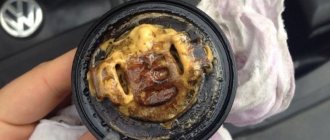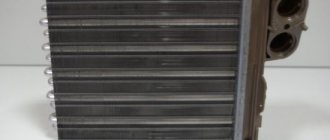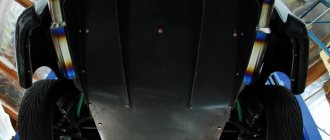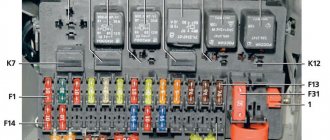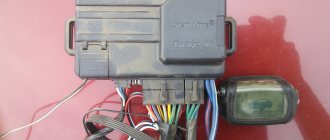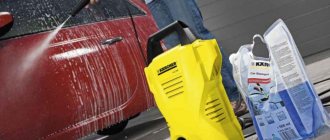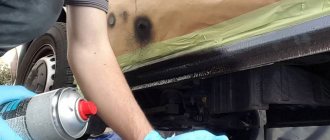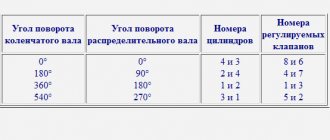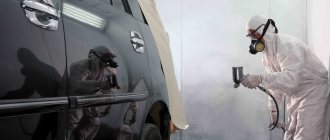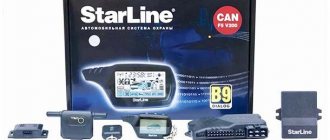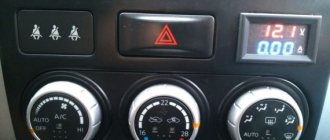The market for anti-corrosion materials is very wide, but material such as Movil enjoys well-deserved recognition, which, together with its low price, puts it in first place in popularity in our country.
There is a practice of using the concept “Movil” as a collective term denoting all materials for anti-corrosion treatment of a car, which is fundamentally wrong.
Movil for cars is, first of all, a preservative that prevents metal from coming into contact with moisture and air, which effectively prevents corrosion. It received its name in honor of the cities of Moscow and Vilnius, in whose research institutes it was developed.
The main components of this material are machine oil, drying oil, thanks to which Movil has a characteristic yellowish-brown tint), and corrosion inhibitors. To obtain a substance with optimal viscosity for application by spray or brush, kerosene or white spirit is added to Movil. It should be noted that the first one erodes faster, which allows you to quickly get rid of the characteristic odor after treatment in the car, but the second one allows the protective layer to retain its plasticity longer and not be subject to drying out and cracking.
What is "Movil"
"Movil" is an anti-corrosion agent that can stop the spread of rust and protect the part from damage. It was created back in the 70s of the last century by scientists from Moscow and Vilnius, during the period when the assembly of the Italian FIAT model began on the basis of the domestic VAZ.
The Italians always treated car body parts with anti-corrosion agents, but the Soviet plant did not have such compounds in its arsenal.
Initially, the product was purchased in Sweden, but VAZ management considered such costs inappropriate, and set the task for its specialists to develop an analogue, but with a cheaper and simpler composition. This is how Movil appeared in the arsenal of the Soviet automobile industry.
The domestic development was made on the same basis as a product from Sweden called Tectyl-390, but the original formula was modified, and very successfully. “Movil” was superior to the original in many respects; it began to be used not only in the USSR, but also in many European countries.
Moscow-Vilnius
Many car owners use Movil, however, not all of them know that it is a domestic development.
This composition was developed by a group of scientists from Vilnius and Moscow. At that time, Tektil-309, developed by specialists from Sweden, was used for anti-corrosion treatment in the USSR. "Tektil-309" was especially popular, but it was created by Soviet scientists and was in many ways superior to the Swedish product.
Composition of Movil
"Movil" is a film-forming agent, classified as an inhibitor, based on petroleum products or petroleum-containing products. After applying Movil to a rust-affected area of a body part, penetrant inhibitors penetrate the micropores of iron oxide, transform them into a non-corrosive form, and a durable film of resins is formed on the surface of the area.
This effect is achieved thanks to the thoughtful composition of the product. It includes:
- motor oil and drying oil,
- kerosene and solvent (white spirit),
- inhibitors and zinc,
- rust converters.
Not all formulations include transformative substances. When purchasing Movil, you should give preference to those options that have o or “with converter” on the packaging.
Most people use tannins as a converter - hydrolyzed or condensed substances that can retain and bind other components of the composition. After contact with iron oxide, tannins are converted into water-resistant tannates, which greatly increases the effectiveness of the Movil anti-corrosion agent.
Briefly: why do we need Movil?
The primary task for which Movil is created and used to this day is to protect the body and other metal parts from corrosion.
Today, it is customary to call almost any anti-corrosion agent Movil. But do not forget that in the beginning only those anticorrosion agents that contained motor oil, drying oils and corrosion inhibitors were called this way. The unique recipe has been used since Soviet times; it was developed by specialists from research institutes in Moscow and Vilnius, hence the original name.
This product makes it easy to treat hidden cavities
Modern anticorrosion agents have almost completely preserved the original composition and are now created on the basis of:
- motor oil;
- drying oils or other film-forming substances;
- anti-corrosion substances;
- solvents.
Each component has its own individual function. For example, thanks to motor oil, a protective layer is created on the metal surface of the body, isolating it from the effects of oxygen. In addition, the oil prevents the body and important elements from coming into contact with water, steam and other substances hazardous to metal.
Movil in cylinders is convenient due to application
The task of anti-corrosion additives is to stop pockets of rust and stop their development, simultaneously preventing the emergence of new pockets. Thanks to these components, when applying the composition, a special film is formed that protects the applied layer from rapid evaporation, mechanical damage and contamination.
The solvent is added to ensure that the consistency is moderately viscous. It is on this that the change in the individual properties of the composition depends. For example, anticorrosive with the addition of kerosene has the weakest odor, which quickly disappears. But Movil with white spirit retains its plasticity longer, resists cracks better, dries more slowly, but has a more persistent odor.
How strong the smell of the product will be depends on the solvent added by the manufacturer.
Release forms of Movil and leading manufacturers
On the Russian market, this anti-corrosion agent is available in three forms at once - in the form of an aerosol or paste, in liquid form, sold in canisters with a volume of usually 3 liters.
The easiest way to work with Movil is in the form of an aerosol, but it costs much more than its analogues. For a bottle with a volume of 250 to 300 ml you will have to pay from 500 to 700 rubles. You do not need to have special skills or knowledge to treat a rusty area with an aerosol. The only rule is that you need to remove traces of corrosion from the part and always keep the bottle strictly vertical when working.
Liquid Movil, which is sold in cans, costs the least. The container is equipped with a special attachment that makes work easier. 3 liters of the product will cost no more than 450 rubles, depending on the pricing policy of the retail outlet and the starting price in the form of a paste sold in plastic or tin cans with a volume of 850 mg. It will cost from 200 to 300 rubles. In order to work with the paste, you will need to dilute it in the proportions recommended by the manufacturer with a solvent, usually white spirit.
In their reviews of the Movil product, both professionals and car enthusiasts note the products of such domestic companies as Agat-Avto, Astrokhim and Razvitie PKF.
Classification of Movils by chemical composition
In addition to the classic Movil formula, some manufacturers try to add something of their own in the form of one additive or another. This somewhat changes the properties of the anticorrosive, but also significantly affects the cost of the coating. The following compositions are distinguished:
- regular Movil without additives;
- composition with added zinc;
- composition with the addition of corrosion converters.
We will not consider the usual Movil, but will pay more attention to its modifications. Zinc Movil is distinguished by the fact that before its use there is no need to remove corrosion - damaged areas are immediately treated with Movil containing zinc, which will remain after application of the coating
The zinc coating will significantly increase the service life of body elements, since it will create auxiliary protection while the car is moving.
Zinc Movil is distinguished by the fact that before its use there is no need to remove corrosion - the damaged areas are immediately treated with Movil containing zinc, which will remain after the coating is applied. The zinc coating will significantly increase the service life of body elements, since it will create auxiliary protection while the car is moving.
The corrosion converter contained in Movil independently eats away rust, so you won’t need sandpaper or a grinder before processing.
Advantages of modified Movils:
- it will take less time to process surfaces;
- less financial costs;
- less labor-intensive to work with.
The only drawback of the modifications is their higher cost.
Scope of application of anti-corrosion agent "Movil"
"Movil" is a kind of preservative that prevents contact of metal parts with moisture and other substances that cause corrosion. You can treat any body parts with this product, but you should carefully avoid getting it on plastic and rubber elements. The scope of Movil is quite wide. The product can be applied to
- body elements or their individual sections,
- welding seams after repair,
- arches and hidden cavities in hard-to-reach places,
- side members and door pockets,
- hood and trunk elements,
- "casings" of headlights, floor coverings and other parts.
Experts recommend processing the entire body, even if only one part has been replaced, and spot welding repairs have been performed.
It is strictly not recommended to treat body parts from the inside of the cabin with Movil. The fact is that it has a specific chemical smell that lasts for quite a long time. Those who cannot tolerate such aromas or those who are allergic to substances included in Movil simply will not be able to use the car.
How to dilute Movil?
If what you see in front of you is not a pasty mass, then nothing. Any additives designed to improve the fluidity of the original composition and speed up the application process only lead to a deterioration in the quality of the anti-corrosion or conservation treatment. Yes, this composition dries faster (especially if you add white spirit, solvent or gasoline) But! The surface tension of the resulting film worsens, and the slightest impact in the problem area damages the integrity of the coating. The owner of the car will not be able to track the onset of corrosion in a timely manner, so he will blame the poor-quality composition of Movil for the rust that appears. And in vain.
Since the product is diluted in order to facilitate the processing process, it is better not to reduce the viscosity of Movil, but to treat with the drug heated in a water bath: in this case, the composition of the original drug remains the same. The heating process can be repeated as many times as necessary.
Dilution with chemically aggressive compounds not only increases the toxicity of the product for the user, but can also cause partial paint slippage.
How to use Movil
For any form of release of the anti-corrosion agent, the manufacturer includes instructions for its use. It is important to understand that if you simply apply the composition to the area of the body where rust has formed, it will not disappear anywhere. It is necessary to carry out the preparatory work correctly:
- clean the car from dirt and road reagents, dry it thoroughly,
- clean the area with traces of rust - with sandpaper, grinder, grinder or brush,
- rinse the surface again, preferably with a stream of running water, dry it,
- apply the anti-corrosion compound following the attached instructions for its use,
- if necessary, apply one or more layers of Movil.
Important: if several layers of anti-corrosion agent are applied, then each layer must be thoroughly dried, preferably naturally.
Using the same principle, you can treat the entire car body twice a year, after first cleaning and drying the areas where traces of rust have appeared. Such body maintenance will protect its parts from the negative effects of atmospheric phenomena (rain, sun rays), reagents that are scattered along the roads in winter.
How to wash Movil?
Removing product from old paintwork is a labor-intensive process. The inadmissibility of using aggressive solvents has already been mentioned above. Therefore, it is necessary to use substances that are less effective, but do not damage the surface of the car. Among the possible options:
- Kerosene (preferably aviation fuel).
- Isopropyl alcohol.
- A solution of laundry soap in turpentine (50/50).
A little trick: if you still dare to try gasoline, then the surface cleaned from Movil should be IMMEDIATELY treated with any car shampoo. The same should be done when using kerosene.
Safety precautions when working with Movil
"Movil" is an anti-corrosion agent based on chemicals, most of which are dangerous to human health. The need to work indoors requires you to take certain precautions:
- the space should be well ventilated,
- there should be no open fire or hot stoves nearby,
- the floor plane under the machine must be covered, since the product is difficult to remove,
- hands and face must be protected with special clothing - gloves, mask, goggles,
- It is necessary to work with Movil in a high-quality respirator,
- If the product gets on an open area of skin, remove it immediately, and if it gets into the eyes or mucous membranes, consult a doctor.
After treating it with Movil anti-corrosion agent, you can use the car no earlier than three days later. The point is not only that the treated areas must dry, but also the composition - Movil contains volatile chemicals and compounds that are dangerous to the respiratory system of the human body.
Movil with a rust converter - aerosol and liquid, is used to preserve hidden cavities in the car body. Its purpose is to transform existing rust and prevent the formation of new ones. This is just one of the anticorrosion agents, but it is one of the first to be produced in Russia, therefore it is best known to car enthusiasts.
Initially, the formula of this product was developed by the Moscow and Vilnius Research Institutes, which was reflected in the name. Today, this formula has been improved and various ingredients have been introduced into the composition that improve anti-corrosion properties, including rust converters. Anticorrosion agents in Movil, the name of which is indicated “with a rust converter,” are produced by several Russian companies.
Movil processing
Preparing the car
The underbody of the car, the lower part of the body, is most susceptible to damaging factors. Sand and stones from under the wheels lead to mechanical damage, high humidity and temperature changes create ideal conditions for corrosion.
During preventative treatment, craftsmen pay attention to side members, central pillars, door pockets, sills, and wheel arches.
First of all, all these places are thoroughly cleaned of dirt, not only from road dust, but also from oily traces. After washing, the surfaces are dried. In the warm season - in the open air, in cold periods - using a compressor.
Before treating the car body, you need to carefully inspect the paintwork and identify problem areas. Corroded areas must be cleaned of loose rust and peeling paint using sandpaper or a special wire brush. Then the lesions should be coated with a rust converter and only then begin to apply the product.
Application Features
Depending on the consistency of the product and the form of its release, the necessary tool is selected. To process a car, you do not need expensive equipment; ordinary garage conditions are sufficient.
Proper use of Movil allows you to extend the service life of the body for many years. It is recommended to apply the drug in compliance with the temperature regime, ranging from +10 to +30 degrees Celsius. The greatest protection against corrosion is provided by treating the car with Movil in two or three layers. Please note that it takes about 2 hours to dry one layer.
The anticorrosive agent is distributed over a previously cleaned and prepared surface, including hard-to-reach areas. After this, it is advisable not to operate the machine for several days. It is important to know that Movil is aggressive towards rubber. Therefore, during the treatment of the body, it is necessary to ensure that the substance does not get on the rubberized areas.
Precautionary measures
The components that make up anti-corrosion agents are quite volatile. Inhalation of vapors can lead to poisoning and burns to the mucous membranes of the nose and larynx. Coating the machine with an anti-corrosion agent should be carried out in a room with a constant flow of fresh air.
Keep in mind that there will be a strong unpleasant odor in the cabin for at least 3-4 days.
All work with Movil must be carried out wearing gloves and protective clothing. In the case of using aerosols, it would be useful to wear glasses or a mask to cover your eyes and face from particles of chemically active substances.
Composition and principle of action of Movil
Movil with a converter belongs to PINS - film-forming inhibited petroleum compositions. Its action is that, thanks to penetrant inhibitors, the product penetrates into the micropores of iron oxide, the converter transforms the oxides into a non-corrosive form of iron, and polymer resins form a film on the surface. The film blocks the access of water and oxygen, making further oxidation process impossible.
This anticorrosive contains the following substances:
- drying oil;
- engine oil;
- White Spirit;
- kerosene;
- rust converter;
- inhibitors.
What kind of converter is included in Movil depends on AGAT-AUTO; tannin is used as a converter, transforming residual oxides into iron tannate.
How long does it take for Movil to dry?
Drying time depends on the ambient temperature. Under normal conditions (20±1ºС) the product dries in no more than two hours. Since the limiting temperature for optimal use of the product is considered to be the range of 10...30ºС, it is worth knowing that for the lower temperature limit Movil will dry in 3...5 hours, and for the upper limit - 1.5 hours. At the same time, “dry” is an imprecise concept; Movil should form a continuous pliable film, which gradually thickens, and this happens in 10...15 days. It is not easy to wash off such a film.
Unfortunately, it is difficult to more accurately indicate the drying time, since everything is determined by the concentration of the solvent in the initial composition of the product.
Manufacturers
Today, Movils with rust converter from the following manufacturers are on sale:
- "Eltrans" - aerosol with a rust converter;
- "Astrokhim" - "Movil Antiruster", an aerosol with a rust converter;
- “AGAT-AUTO” – “Car preservative “Movil””, aerosol with a rust converter;
- “Development of PKF” - “Movil NN MasterWax with rust converter”, liquid and aerosol.
Quite good reviews about the anticorrosive agent produced by Eltrans. It has a memorable design: the bottles depict a medieval knight. They also speak well of Movil NN MasterWax produced by PKF Razvitie.
Which Movil is cheaper?
Today, Movil aerosols, which contain a rust converter, are in approximately the same price range - about 300 rubles per liter. The final price may vary depending on the region where auto chemicals are sold and the amount of anticorrosive agent purchased. Traditionally, products in small packages are a little more expensive.
Liquid products cost about half as much as aerosols (about 150 rubles per liter). If you plan to apply the product to the surface to be protected using a brush, then there is an opportunity to save money. The liquid can also be applied with a sprayer.
Use of Movil aerosol
Anti-corrosion composition in cans has its advantages:
- due to the small size of the bottle, access to almost any body surface is provided; for treating hard-to-reach places, the bottle is equipped with a special nozzle-tube;
- to work with the spray you do not need special equipment and a compressor; the work can be done in almost any conditions;
- As a rule, such a product does not have such a strong odor;
- The car can be used within a few hours after applying the anticorrosive agent.
But aerosols are also not without their disadvantages, and the disadvantages are quite significant:
- The composition is not used as economically, resulting in a less even layer;
- It takes longer to process large areas of the body;
- chemical spray is more expensive.
Using a spray bottle is convenient for treating small surfaces, for example, a welding seam; before use, the bottle with aerosol liquid must be shaken several times.
What surfaces is Movil anticorrosive agent intended for?
Anticorrosive agent with a rust converter can be used on metal surfaces, including those coated with paints and varnish. Do not coat rubber parts or any surfaces coated with synthetic mastics or other synthetic chemicals with this product.
Car owners use Movil mainly for treating closed cavities - sills, pillars, surfaces behind the radiator trim. Using it to protect the bottom and external parts is impractical, since it does not have mechanical strength. You should not use this anticorrosive agent inside the car, as it has a more pronounced chemical smell than regular Movil.
"Movil 2M"
This is a domestic product. The company is located in Moscow. The drug is supplied in a can. After processing, a thin transparent and fairly uniform film is created on the surface. This product withstands the Russian winter well. If a drop of this composition gets on the paint, it can be easily removed with gasoline. The product impregnates rust and has medium fluidity.
The product displaces water well, but the protective layer is not very strong, which means it is ineffective. Sooner or later, rust will still appear. Motorists say that it is better not to use it - it is a waste of money.
Instructions for use
Movil is applied to easily accessible places as follows.
- Surface preparation: dirt and rust (the top loose layer of oxides) are removed from the metal, after which it is degreased.
- Drying the surface.
- Applying the 1st layer of Movil (the temperature should be within +10° C to +30° C). The spray is applied through the spray head, and the spout and tube are removable (they are designed for hard-to-reach areas). The liquid is applied with a roller or brush.
- Intermediate drying. If necessary, it can be accelerated by pouring warm air over the treatment area.
- Applying the second and third layers (with another intermediate drying).
- Final drying. The final drying of the composition occurs approximately two hours after applying the last layer.
If during processing the product gets on the front surface, you need to immediately wipe it with a bitumen stain cleaner.
How to treat a car?
An important point in using Movil is the ability to apply it independently to a car, without the need to contact a special service. Many new drivers do not always know what Movili for cars is and how to use the product.
And in order to do everything correctly, you must adhere to a certain order in your actions and strictly follow the instructions:
- It is necessary to prepare the surface to be treated: to do this, it is cleaned of dirt and rust, and then wiped with a degreasing agent;
- When the bottom of the car is processed, it is recommended to rinse it under the pressure of hot water, this will clear it of accumulated contaminants;
- Before applying the product, you need to wait a little until the surface dries;
- After the metal has dried, you can apply the first coat of the product to it, and also let it dry before applying subsequent ones.
Movil is applied from a special gun device and sprayed in the right places under pressure. If the surface is open, application can be done using a brush.
You should avoid using the solution inside the car, as it is toxic and has a rather pungent odor. Staying in the car until it dissipates will simply be harmful to health.
To understand how long it takes for Movil to dry, you can read the instructions that come with it. As a rule, complete drying occurs after two hours.
How to treat hidden cavities?
The processing of hidden cavities has its own characteristics.
- It is necessary to remove those elements that prevent access to the surfaces being treated.
- Rinse the cavities with water through the drainage holes. Before washing, check and clean the holes if necessary.
- Treat the cavity with a rust converter, then rinse with an alkaline reagent. The reagent is selected depending on the type of converter.
- Dry the cavity with warm air.
- Apply layers of anticorrosion with intermediate drying.
Sprayers with a working pressure of 4-12 MPa (airless application) or 2-4 atmospheres (air method) are suitable for applying liquid.
Precautions during operation
Do not allow the product to come into contact with unprotected areas of the body. Movil should be applied either outdoors or in a well-ventilated area. If the product does get on the skin, you need to wash it off with white spirit. Anticorrosive is a flammable material, so you should not smoke while applying it.
During storage and transportation, it should be taken into account that exposure to direct sunlight and heating above + 50º C, as well as being near sources of open fire, is unacceptable. In aerosol cans, the product is under pressure, so the temperature of transportation and storage should be even lower - up to + 40º C. Another safety measure is to store auto chemicals in places inaccessible to children.
What precautions must be taken?
When processing with the product, the following safety precautions must be observed:
For safe operation of the car after treatment, you need to know how long it takes Movil to dry. On average, the smell in the salon lasts three days after application. During this time, you should not get into a car to avoid serious poisoning. When applying, keep in mind that Movil produces toxic fumes. Inhaling them can easily cause poisoning. Therefore, it is recommended to apply the composition in a well-ventilated area. When, during the processing process, Movil gets into the eyes, mucous membranes, skin of the hands or face of other parts of the body, it is possible to get a serious burn
It is important to work with this composition only in closed clothing. It is advisable to wear a respirator
This way you will protect yourself from inhaling toxic fumes. Also use protective gloves for work. When applying the product using an aerosol or spray, do not forget to wear special safety glasses.
Myths and facts
There are many rumors about Movil among car owners. Some of them turn anticorrosive into an extraordinary miracle remedy, while others, on the contrary, deny all the positive aspects. It is worth sorting out the fables in order to use the product for its intended purpose and get the expected effect as a result.
Movil with a converter can be applied to metal with any layer of rust - the chemical will “eat” everything. In fact, the loose layer of oxides must be cleaned off. The converter only copes with the residual layer, which is difficult to remove from the metal. That is, using such a product, the metal does not need to be cleaned until it shines, but the “growths” of rust and dirt need to be removed.
Aerosol consumption is less than liquid. In reality, both the liquid and the spray should form a uniform, thin layer on the metal. In both cases, the consumption will be approximately 400-500 ml per square meter.
Movil, produced in Soviet times, was real, but now they sell compounds that are much worse. In reality, only counterfeit products can be worse in quality, since official manufacturers are interested in good reviews and increasing sales of their products, and not in complaints and returns of low-quality chemicals. At the same time, the consistency and appearance of the anti-corrosion agent may differ from its “grandfather”, as manufacturers try to improve qualities such as fluidity during application, resistance to high temperatures, and anti-corrosion properties. Improvement occurs due to new inhibitors and additives, for example a rust converter, so the smell, color, and density of the composition changes.
It is enough to apply the product once when purchasing a car. The opposite, but equally incorrect opinion is that cavities need to be smeared with Movil every month. Those who have used such auto chemicals know that the product will protect the car for several years if hidden cavities have been treated, and will last no more than a year on surfaces exposed to mechanical stress.
Movil, what is it? This question interests many who have encountered corrosion on the car body, and why Movil is needed immediately becomes clear - in order to protect the body from corrosion. Despite the fact that modern cars are well protected from corrosion, this does not mean that rust will not form, since winter driving around the city has a very unfriendly effect on the body’s resistance to corrosion. Movil for cars: we will now find out how to use it.
Therefore, it is advisable to additionally treat the car body with Movil, the method of application of which is not as complicated as it may seem at first. What is Movil for cars? This is simply an indispensable tool for those who love their car and drive it all year round.
Of course, in addition to Movil, there are many other products on the market that are created to improve the anti-corrosion properties of a car. But Movil has proven itself very well, because it is inexpensive, which is why it is so popular in Russia, and its quality is at the level of its foreign analogues. Movil is a substance that prevents metal from coming into contact with the external environment, namely moisture and air. If the metal is not exposed to moisture, then rust will not form.
Advantages of Movil
The product can be applied both to unpainted metal surfaces and to any coatings treated with varnishes and paints. After metal processing there is no need for drying. As a result of application, a reliable protective layer is created that not only prevents moisture from reaching the metal, but also repels it. Other advantages include the absence of a negative effect on metal and any paints. All this makes the product quite effective in combating corrosion. Many car enthusiasts successfully use Movil. What it is? This is a powerful weapon for fighting rust.
This drug is simply irreplaceable when you need to defeat pockets of corrosion in hard-to-reach areas of the machine. It differs from other products in its high fluidity - the substance easily penetrates even into minor cracks and cracks.
Movil for cars: how to use it correctly
Movil for cars: how to use it is quite simple to understand - you just need to apply it to arches, hidden cavities, welds, anywhere where moisture can linger. But before applying, you need to carefully treat those places where rust has already appeared. Because even if you apply Movil to a rusty part, the rust will still continue to develop, but more slowly.
But Movil has a rather specific smell, so it’s better not to treat anything with it in the salon. What color is Movil - when it dries it turns dark brown. When using Movil, it is important to thoroughly dry the surface so that there is no moisture there at all, otherwise the moisture will simply remain under the protective layer, and perhaps corrosion will begin to appear under the protective layer, which will not lead to anything good.
When the surface is prepared, you can apply Movil either by spraying or coating, depending on the case, you need to select the correct consistency of Movil using a solvent. If the mixture turns out to be very thick, it may not penetrate into some seams, and it will also lie unevenly. If the mixture turns out to be very liquid, it may not stay on the surface. Also, the consistency depends on the temperature, so it is best to apply Movil in a warm room. If you do work in the heat, the material will become more liquid and the smell will be very pungent, so in the heat you need to add less solvent.
Movil aerosol is available for sale; it has the correct consistency already selected and does not require application devices. In the case of an aerosol, anti-corrosion protection must be done in several layers, because the thickness of one layer is quite small. The durability of this layer is also less, since the spray here is quick-drying.
If hidden cavities are found, they must be treated by extrusion without spraying; for this you can use a special metal tube. The main thing is to achieve an even distribution of Movil.
Let dry
In addition, after Movil has been applied to the body, you must wait at least one day for Movil to thicken. Moreover, there is no need to dry anything additional. It is not necessary to wait until the substance has completely dried, because Movil for cars should not dry out, it simply thickens, becomes elastic, but not dry.
Which parts of the car are recommended to be treated with Movil:
- door pockets,
- arch cavities;
- spars;
- hood and trunk;
- headlight housings;
- floor thresholds;
- body pillars.
But open surfaces that are exposed to the external environment, such as the bottom of a car, do not need to be treated with Movil, since it is better to use an anti-gravel coating for this and provide full anti-corrosion protection.
It is believed that Movil contains a rust converter, so the surface does not need to be pre-treated. But there is not much of this converter there, so it is better to treat the body before using Movil - completely remove the rust, and then apply Movil.
How to prepare a car for processing?
First you need to prepare the surface and then apply Movil directly. What it is? This is a simple preparation that will make the drug even more effective.
First of all, the car must be thoroughly washed. If you plan to treat the bottom, then it is washed while the car is on the lift. It is best to use a pressure washer with hot water. After the procedure, the body must be thoroughly dried.
Next, various defects that exist on the metal surface are eliminated. Loose rust should be removed. Then an anti-corrosion agent is applied. When the product dries, a protective film with a layer of 40 to 60 microns will begin to form.
Safety during use
When working with Movil, you need to ensure that there is good ventilation, and remember that Movil contains components that are easily flammable. Also, do not allow Movil to come into contact with the skin or other parts of the body.
It is necessary to ensure that Movil does not come into contact with rubber or plastic parts, because it will have a negative effect on them. You also need to remember that a stain of frozen Movil is difficult to remove later, so you need to apply the substance carefully.
It also happens that excess substances can drain from the car onto the garage floor. Therefore, you can first lay down oilcloth to keep the floor clean.
It is also advisable to check the condition of the car’s anti-corrosion coating every few months. If it is noticed that the Movil has hardened and is no longer elastic, this means that the treatment must be repeated, and the composition must be made more liquid. But the old layer must be removed using a solvent or using a product that removes bitumen stains.
If you follow all the rules and recommendations for using Movil, you can achieve excellent protection of the car body from corrosion for a fairly reasonable price.
And then a video about how you can move a car with your own hands:
Movil with zinc
Top 20 best car video recorders in price-quality ratio: 2019-2020 rating and how to choose a budget model according to experts + user reviews
When patenting new compositions of “their” Movils, manufacturers often look for alternative ways of adding components that enhance the anti-corrosion properties of the original composition. Among the most common is zinc. It is usually included in protective primers for metal, however, judging by reviews, it also has a positive effect as part of anti-corrosion coatings.
Unlike sparingly soluble iron tannates, zinc dioxide, which is formed as a result of reactions, is a fairly plastic component in a humid environment, and the rate of oxide formation will not slow down. But zinc will show maximum activity only when the original metal surface is completely free of rust. Therefore, Movil with zinc is effective not on any surface, but only on the prepared surface of steel parts. The final result is achieved not mechanically, but electrochemically.
Based on these considerations, both zinc and tannic acid are added to some of Moville’s formulas.
